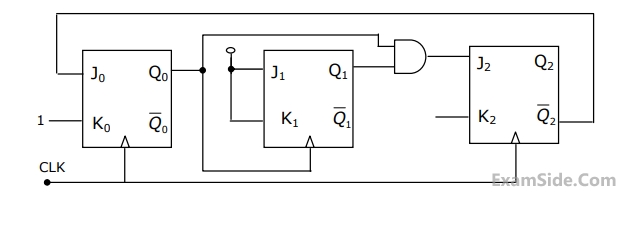Digital Circuits
1
GATE ECE 1999
Subjective
+5
-0
The circuit diagram of a synchronous counter is shown in the figure. Determine the
sequence of states of the counter assuming that the initial state is ‘000’. Give
your answer in a tabulor form showing the present state QA(n), QB(n), QC(n), J-K inputs ( JA, KA, JB, KB, JC, K,) and the next state $${Q_{A\left( {n + 1} \right)}},\,{Q_{B\left( {n + 1} \right)}},{Q_{C\left( {n + 1} \right)}}$$ From the table, determine the modulus of the counter.
2
GATE ECE 1998
Subjective
+5
-0
The mod-5 counter shown in figure counts through states Q2 Q1 Q0 = 000, 001, 010, 011 and 100.


(a) Will the counter lockout if it happens to be in any one of the unused states?
(b) Find the maximum rate at which the counter will operate satisfactorily. Assume the propagation delays of flip-flop and AND gate to be tF and tA
3
GATE ECE 1997
Subjective
+5
-0
A sequence generator is shown in figure. The counter status (Q0 Q1 Q3) is intialized to 010 using preset/clear inputs.
The Clock has a period of 50ns and transitions take place at the rising clock edge.
(a) Give the sequence generated at Q0 till it repeats.
(b) What is the repetition rate for the generated sequence?
The Clock has a period of 50ns and transitions take place at the rising clock edge.
(a) Give the sequence generated at Q0 till it repeats.
(b) What is the repetition rate for the generated sequence?

4
GATE ECE 1996
Subjective
+5
-0
A state machine is required to cycle through the following sequence of states:



One possible implementation of the state machine is shown figure. Specify what signals should be applied to each of the multiplexer inputs

Questions Asked from Marks 5
GATE ECE Subjects
Signals and Systems
Network Theory
Control Systems
Digital Circuits
General Aptitude
Electronic Devices and VLSI
Analog Circuits
Engineering Mathematics
Microprocessors
Communications
Electromagnetics